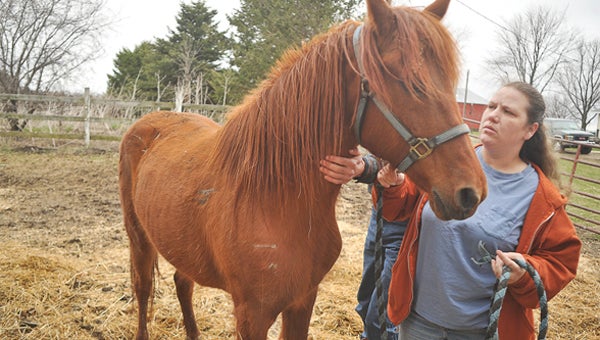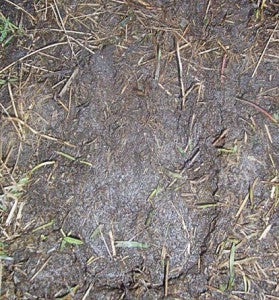A puma or a puppy?
Published 8:45 am Thursday, May 26, 2011

Jolene Morrison holds Sapphire who displays wounds on her shoulder and side from a possible cougar attack in April on a farm northwest of Austin. -- Herald file photo
One month after rural Austin residents suspected their horses were attacked by a puma, no big cat sightings or evidence have materialized. But that’s not the end of the story for some.
John Lutz of the Eastern Puma Research Network, said scars on the front, right side of the most severely injured horse were consistent with a juvenile puma’s attack.
“Such injuries shown in the picture would be consistent as to what an inexperienced (young) puma, probably between 18 and 30 months of age, might try,” Lutz said.

This is a photograph of a paw print taken from the farm where horses were possibly attacked by a cougar.
He added the puma would attack from the side on such a large animal so it wouldn’t get kicked. The animal was likely young, in unfamiliar territory and possibly desperate for food, according to Lutz. An adult puma would likely have not attacked a horse.
A faint foot print found after the suspected attack was photographed by the Freeborn County Sheriff’s department. Lutz said his first impression from the photograph was a feline track, as the back was oval shaped. However, DNR area wildlife manager wasn’t as quick to draw conclusions.
She said making those generalizations would mean filling too many gaps, and the DNR doesn’t want to release information on the subject if its not sure.
Department of Natural Resource officials and Lutz both said any possible cougar would have likely been on the move, which could be the cause.
According to EPRN and other volunteer and professional research groups, attacks on livestock across the Midwest have risen in the last few years. Lutz said pumas are more prevalent than most people think.
And even though area DNR officials initially leaned toward other possibilities, such as a large dog, they haven’t ruled out pumas, either.
“Just because we can’t document it doesn’t mean it never happened,” said Vorland.
In the past few years, the DNR has received reports of cougar sightings near Albert Lea, but nothing has ever been positively identified. Most calls were “I thought I saw a cougar kind of things,” Vorland said. According to the DNR’s website, many sightings are later proven to be large dogs, as dog tracks are often found where cougar tracks should have been.
However, Vorland added one cougar was positively identified several years ago in southern Mower County. She said it was likely an escaped pet, another reason some cougars are seen in unlikely areas.
But through all of last month’s investigation, Vorland said it’s not something they’re going to raise concern about. That’s just the opposite of what the EPRN does. The network wants to notify people that cougars are more populous than may be thought.
In the meantime, the DNR will play it by ear.
“We haven’t heard of any more attacks on horses, which is good news. We’ll just keep an open mind, I guess,” Vorland said.


